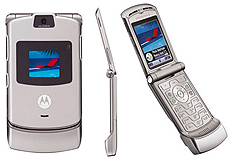
In the global phone handset market Motorola went from the market leader to market laggard in just six years. Its earnings fell from US$4bn to $0.6bn and its share price from $180 to $46 over this time. Theirs is a cautionary tale of what can happen when you fail to recognize the changes occurring in the wider market and how quickly customer expectations can change.
How could the company that first invented the mobile phone 35 years ago and then hold the No. 1 market position for most of the next three decades make such a bad error in judgment?
Motorola’s demise actually stemmed from its greatest success – the RAZR handset. Launched in 2003 the ultra-thin handset with the clam shell appearance sold a staggering 110 million units over the next four years. Its impact was so extraordinary that the industry magazine PC World rated it #12 in The Greatest Gadgets of the last 50 years. Buoyed by this success the company introduced nine separate versions of the RAZR in quick succession.
However, little else was developed during this time leading the influential website Trusted Reviews to label the Motorola products repetitive and un-innovative. By focusing inwards rather than outwards Motorola seemed to miss the paradigm shift occurring in the handset market away from traditional cell phones, like the RAZR, to feature-rich touch screen smart phones, such as the iPhone and the LG Chocolate.
Instead, by choosing to milk the Motorola RAZR cash cow for too long the company unwittingly forced its customers away and into the arms of their competitors who had recognized the market changes occurring and built the products that consumers wanted.
Their CEO explained it like this
“we failed to see the trends coming in the smart phone and 3G with the kind of foresight and customer attention that we should have. We didn’t see the world’s overall change in perception of the mobile phone, from just a voice-calling phone to a self-contained communications platform, and that failure left us behind.”
Motorola let its guard down after its major success with the RAZR and it has never been able to fully recover.
Very few companies are successful in sustaining a dominant position for a long period of time and those that do are continuously innovating, even when there does not appear to be a pressing need to. While it may seem counter-intuitive these companies choose to attack their own position in the market, rather than waiting to be attacked by their competitors. The logic being that sometimes customers don’t really know what they want until you offer it up to them.
 Gillette is a prime example of this and this strategy has helped to protect its 70% share of the global razor market. Since 1990 its razor division has produced more than 20 new razor products, many of them with revolutionary product designs and features. Arguably they may not have needed to innovate to this extent (after all, the fundamental purpose of razors hasn’t changed since they were first invented) but clearly they were not prepared to give up a single inch of their market share without a huge fight.
Gillette is a prime example of this and this strategy has helped to protect its 70% share of the global razor market. Since 1990 its razor division has produced more than 20 new razor products, many of them with revolutionary product designs and features. Arguably they may not have needed to innovate to this extent (after all, the fundamental purpose of razors hasn’t changed since they were first invented) but clearly they were not prepared to give up a single inch of their market share without a huge fight.
This is one of the major differences between average and successful companies – that is, innovation is continuous and these companies relentlessly attack themselves and put themselves under pressure to anticipate what the market might demand next. They don’t wait for the sales of a product or service to mature or decline prior to introducing a modified version into the market. They aim to exploit emerging market opportunities as an offensive growth strategy while also closing down market gaps as a defensive tactic to shut down the options for their competitors.
This keeps them fresh and allows them to sustain their market position. Essentially, they understand that you need to change before you have to change. It’s a courageous approach but today an absolutely necessary one…

